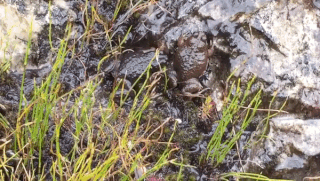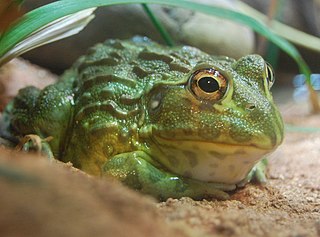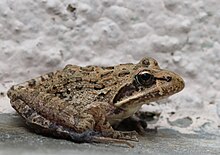
Megophryidae, commonly known as goose frogs, is a large family of frogs native to the warm southeast of Asia, from the Himalayan foothills eastwards, south to Indonesia and the Greater Sunda Islands in Maritime Southeast Asia, and extending to the Philippines. Fossil remains are also known from North America. As of 2014 it encompasses 246 species of frogs divided between five genera. For lack of a better vernacular name, they are commonly called megophryids.

The Rhacophoridae are a family of frogs that occur in tropical sub-Saharan Africa, South India and Sri Lanka, Japan, northeastern India to eastern China, south through the Philippines and Greater Sundas, and Sulawesi. They are commonly known as shrub frogs, or more ambiguously as "moss frogs" or "bush frogs". Some Rhacophoridae are called "tree frogs". Among the most spectacular members of this family are numerous "flying frogs".

Arthroleptis is a genus of frogs in the family Arthroleptidae found in tropical sub-Saharan Africa. Their common names include screeching frogs, sometimes simply squeakers.

Pyxicephalus is a genus of true frogs from Sub-Saharan Africa, commonly referred to as African bull frogs or bull frogs. They are very large to large frogs, with females significantly smaller than males. They may take decades to reach their full size potential and they are some of the longest-living frogs, possibly able to reach ages as high as 45 years.

Tomopterna is a genus of frogs from sub-Saharan Africa.

The raucous toad, also known as Ranger's toad, is a species of toad from Southern Africa.
Pleurodema bibroni is a species of frog in the family Leptodactylidae. Its common name is four-eyed frog, although this name can also refer to the genus Pleurodema in general. The common name refers to two inguinal poison glands that resemble eyes. When threatened, the frog lowers its head and raises its rear. When the frog adopts this posture the poison glands are also raised toward the predator. The predator may also confuse the frog's raised posterior for the head of a larger animal.

The Hogsback frog, or Rattray's forest frog, is a species of frog in the family Pyxicephalidae. It is one of three species within the genus Anhydrophryne. It is endemic to the Eastern Cape province of South Africa.

Cacosternum is a genus of frog in the family Pyxicephalidae that are found in southern and eastern Africa. They have many common names, including cacos, dainty frogs, and metal frogs.
Nothophryne broadleyi is a species of frog in the family Pyxicephalidae found on Mount Mulanje (Malawi). It was monotypic within the genus Nothophryne until four new species were described in 2018.

Poyntonia, is a monotypic frog genus in the family Pyxicephalidae. It was named after J.C. Poynton, a notable herpetologist who worked in southern Africa.

Amietia wittei is a species of frog in the family Pyxicephalidae. It is found in Kenya and Tanzania, including Mount Elgon in the Kenya/Uganda border region. Its type locality is in Molo, Kenya, located near the top of the Mau Escarpment. The specific name wittei honours Gaston-François de Witte, a Belgian naturalist.

Strongylopus fasciatus, also known as the striped stream frog, striped grass frog, striped rana, striped long-toed frog or long-toed grass frog is a species of frog in the family Pyxicephalidae. It is endemic to southern Africa.

Fuelleborn's stream frog or long-toed grass frog is a species of frog in the family Pyxicephalidae. It is found in the mountains of Malawi, Tanzania, and northeastern Zambia. Its natural habitats are montane grasslands at elevations of 1,500–3,000 m (4,900–9,800 ft) above sea level. Outside the breeding season, it can be found far from water. During the breeding season, males call from flooded grass. The egg clusters are laid just above streams, underneath dense vegetation. Tadpoles develop in the streams.
Strongylopus kilimanjaro is a species of frog in the family Pyxicephalidae. It is endemic to Tanzania and only known from a narrow alpine range on the middle slopes of Mount Kilimanjaro, within the East African montane moorlands ecoregion. It is known only from three specimens collected in 1936. The lack of recent records is probably a reflection of very limited survey effort in the area since then.
The Chimanimani stream frog is a species of frog in the family Pyxicephalidae found in Zimbabwe and Mozambique. Its natural habitats are subtropical or tropical moist montane forest, subtropical or tropical high-altitude shrubland, subtropical or tropical high-altitude grassland, and rivers. It is threatened by habitat loss.
Wager's stream frog is a species of frog in the family Pyxicephalidae found in South Africa and possibly Lesotho and Eswatini. Its natural habitats are temperate forest, temperate grassland, and rivers. It is threatened by habitat loss.

Sclerophrys is a genus of "true toads", family Bufonidae, native to Africa and the southern Arabian Peninsula. Originally, all of these species were classified in the genus Bufo. The genus, originally named Amietophrynus, was split due to large enough taxonomic divergence. Ohler and Dubois showed in 2016 that Sclerophrys capensis Tschudi, 1838 is the same species as Bufo regularis rangeri Hewitt, 1935, the type species of Amietophrynus. Because the former name is older, the implication is that Amietophrynus is a junior synonym of Sclerophrys.

The Pyxicephalidae are a family of frogs currently found in sub-Saharan Africa. However, in the Eocene, the taxon Thaumastosaurus lived in Europe.














